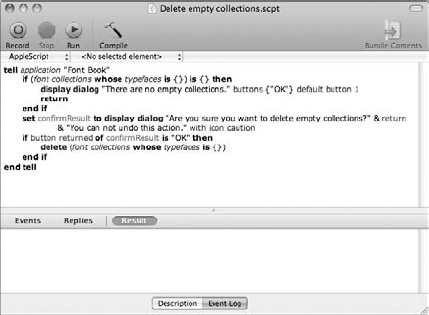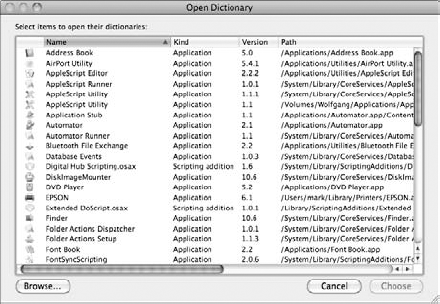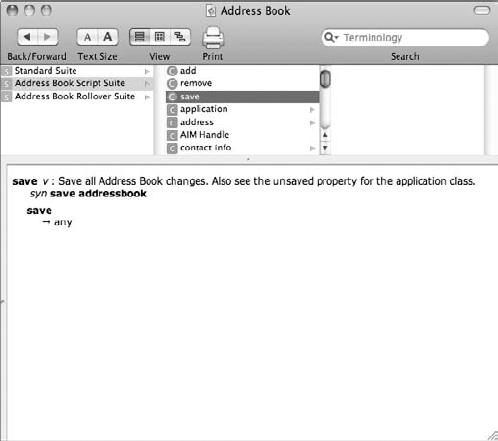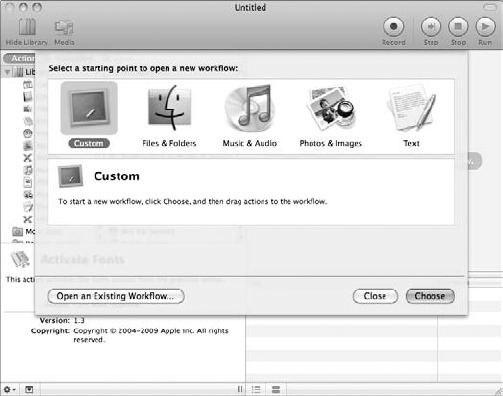In This Chapter
Simplifying your life with AppleScript
Letting AppleScript create scripts for you
Writing scripts on your own
Using Automator to create your own applications
Searching for AppleScript help elsewhere
Using a Macintosh is supposed to make your life easier — and in many ways, it does. But there's a limit to how much your MacBook can do by itself, right? After all, you still have to move your finger on the trackpad, press keys on the keyboard, and read information on the screen to get things done ... or do you? Why not let your computer do the dull chores — such as renaming a thousand digital photographs from your family vacation and organizing them into folders based on the subject of each photo — for you? Although most people are familiar with controlling their MacBooks with the trackpad and keyboard, few realize that they can operate their machines without touching a key or a button, or even glancing at the screen.
If one word could describe what AppleScript is all about, it'd be automation. AppleScript is a technology for automating practically any action that you perform with your MacBook, including both common tasks in the Finder and those that you perform in other applications.
If you've ever found yourself repeating some task more than once, you're an ideal candidate for becoming an AppleScript techno-wizard. AppleScript is particularly good at taking the boredom and tedium out of using your laptop by performing all sorts of tasks automatically. To illustrate, consider a few jobs that would take a fair amount of time to do by hand but are a snap with AppleScript:
While writing your next best-selling Great American Novel — or For Dummies book on Mac OS X — you make a mistake and misnumber the chapters. All the chapters have a filename bearing the chapter number, but they're all off by one. Sure, you could rename each file by hand, but your book is a large tome and renumbering 42 chapters manually doesn't sound like much fun. (Take my word for it. Please.) It'll require several minutes and lots of tedious attention on your part, not to mention introduce the likelihood of human error. But wait, there's another way! When using a simple AppleScript of only a few lines of code, you can rename the chapters in seconds whilst you go grab another Diet Coke.
You're a neat individual and think that your MacBook should reflect your penchant for order — in fact, you like your Desktop icons to be placed just so. Being left-handed, you prefer the icons over on the left side of the Desktop, like some of those inferior operating systems. In this situation, an AppleScript can help you do things that aren't humanly possible; not only can you rapidly rearrange the icons on your Desktop, but you can do so with pixel-point accuracy. Without AppleScript, it'd be nearly impossible to precisely align dozens of icons. And if you could, it would take a long time and probably cause you to go blind.
After a font-download binge, you find yourself with hundreds of fonts. You really want to organize them into separate folders based on the date that you downloaded them. AppleScript comes to the rescue again! With a brief script, you could knock out this challenge without ever looking at a single date. Add a couple more lines of code to the script, and AppleScript will take care of creating the folders, too. Right, you know the word: sassy.
By using AppleScript, you can also often automate your work from beginning to end, despite the fact that you need multiple applications to do so. Look at a few scenarios, and you'll begin to appreciate why AppleScript is such a powerful technology:
You've just completed creating the ultimate library of bagpipe songs in iTunes — no, really! — and you want to share the list with your friends at the next Bagpipers Anonymous meeting. You could easily send everyone in the group an iTunes Playlist, but not everyone in the club has a Macintosh, let alone a computer. This is going to require creating a hard copy for those members without a computer. Because your bagpipe song list contains thousands of songs, you don't want to retype the name of each song. AppleScript can save the day by extracting the song titles for you and compiling them into a list just in time for your meeting.
AppleScript can take care of your computer-owning bagpipe friends, too. With a few extra steps, you can e-mail all of them the list as well.
Being so doggone fond of bagpipes, you want to send your bagpiping friends a special note during the holidays. To help manage your holiday greeting cards, you can create a record in FileMaker Pro or some other database listing the name and address of each person who should receive a card. If you've entered their street addresses in the Contacts section of your e-mail application, AppleScript can aid in transferring the addresses from your e-mail application to the database. Never again will your bagpiping friends miss a holiday greeting ... and the world is a much better place.
As you can imagine, there are literally thousands of ways that you can use AppleScript to automate your workflow. (Whoops, I just used a BST, or Business Software Term. A workflow is a single document or project that one or more people work on using multiple applications. In other words, your document can be automatically manipulated in multiple applications using the same script.)
The easiest way to get started with AppleScript is to use some scripts that others have written already. Scripts are small files that contain a list of commands; this list of commands tells your Mac what function to perform and when to perform it. Fortunately, Apple is kind enough to provide you with several completed scripts with your installation of Snow Leopard. You can find a large cache of scripts in the scripts folder, found in the Library folder, under Scripts.
Many scripts (but not all) end with the extension .scpt. Before you get started running scripts, however, you should know a few things.
Each script that you encounter will be in one of these three formats:
Script application: Some AppleScripts act much like an application. To use one, simply double-click it in the Finder, and off it goes to perform whatever tasks it was meant to do. Depending on an internal setting of the script, it might quit when it's finished doing its thing. Most often, the script completes its mission and quits. Scripts are typically identified by the icon that you see in Figure 2-1.
Compiled script: You might also encounter AppleScripts that won't run without the aid of another application. Apple calls these compiled scripts. Although they can't execute on their own, they do have the abilities of a script built in. They just require a host application to use them.
Text file: In addition to compiled scripts and those that act like applications, a third category of AppleScript that you might encounter is a script stored in a text file. Scripts that are stored in a text file also need a host application before they'll do anything. The main difference between a text file script and a compiled script is that you can read a text file script with any application that can open a text file.
Two of the three possible script types (compiled scripts and text files) require some sort of host application before they'll perform any action. Luckily, Snow Leopard provides you with just such a host: the AppleScript Editor application, which comes with Mac OS X and can execute any AppleScript with ease. With the AppleScript Editor, you can also do much more, including
View or modify an AppleScript
Create a new AppleScript
Check an AppleScript for errors
Save scripts in one of the three possible formats
To launch the AppleScript Editor application, navigate to the Utilities folder (open your Applications folder and then open the Utilities folder) and double-click the AppleScript Editor icon. The AppleScript Editor application displays an empty, script-editing window, as shown in Figure 2-2.
After you have the AppleScript Editor application running, you can run any AppleScript that you can find. To get you started, Apple has conveniently provided a handful of useful scripts. Navigate to the Scripts folder, which is located in the Library folder.
Tip
The scripts are divided into folders based on functionality, such as fonts, mail, and navigation. For example, open the Font Book folder, where you'll find a script named Delete Empty Collections.scpt.
Double-click the script to open it. Because it's a compiled script and not an application script, the AppleScript Editor automatically loads the script and comes to the foreground (see Figure 2-3). This particular script opens the Font Book application and checks for empty font collections. If any are found, the script displays a prompt asking for confirmation and then deletes the empty collection if you click the OK button. To see the script in action, click the Run button or press
Using someone else's scripts is fun and all, but the real joy of AppleScript comes when you create your own. Not only can you customize a script to your own needs and desires, but saving all those keystrokes can really produce a feeling of euphoria. (Okay, perhaps just Snow Leopard power users will actually experience a heightened sense of existence ... you'll be there soon.)
You needn't wear a pocket protector or tape the bridge of your glasses to become proficient with AppleScript. In fact, the AppleScript Editor can get you up and running with AppleScript in no time at all. The secret weapon of the AppleScript author is the Record function of the AppleScript Editor. You click the Record button, perform one or more actions in a recordable application, and then return to the AppleScript Editor, where you click the Stop button. The AppleScript Editor stores each of your actions and compiles the whole list into an AppleScript.
Warning
In theory, this is how it should all work, but in reality, finding recordable Macintosh applications isn't always so easy. The Finder is, perhaps, the most recordable application on the MacBook. Although some other applications support recording, so few do that the Finder could be the only recordable application most Mac users ever see.
To try it yourself, take the following steps to automate actions in the Finder:
Bring AppleScript Editor to the foreground.
If AppleScript Editor isn't currently running, double-click its icon in a Finder window. If it is running, click its icon in the Dock.
Create a new script by pressing

Click the Record button.
Tip
The Record button is one of four buttons positioned near the top left of a new script window. Refer to Figure 2-3.
Switch to the Finder and perform the actions that you want to automate.
When the Finder is active, you can select some icons on the Desktop and move them around, resize any open Finder windows, or navigate to your home directory. Any action that you perform in the Finder should be acceptable fodder for the AppleScript Editor. When you perform tasks in the Finder, the AppleScript Editor automatically generates a script that replicates your actions.
Return to the AppleScript Editor and click the Stop button.
To reactivate the AppleScript Editor, click its icon in the Dock. Click the Stop button to cease the recording of your script.
When you're finished, you should be looking at a complete AppleScript. To test your work, return to the Finder and return any icons or windows that you might have moved or repositioned to their original locations. (You don't want to run a script that doesn't appear to have any effect.) Then return to the AppleScript Editor and click the Run button to watch your automated Finder tasks being performed.
An AppleScript novice can perform all kinds of amazing feats with the recording features of the AppleScript Editor. Because AppleScript uses a kind of pseudo-English language, it's usually pretty easy to figure out what's going on behind the scenes. Consider the following script for an example:
app "Finder"tellactivatewindowList to every window -- save list of open windowssetwith theWindow in windowListrepeattheWindowtellcollapsed is true then -- do nothing, because the window is collapsedifelsecollapsed to truesetifendtellendrepeatendtellend
(By the way, in the preceding code, I bolded and italicized the commands you'll be working with, but they don't have to be bolded for the script to work.) Anyway, the first thing that you might notice about this script is the first line: the tell command, which indicates that this script relates to the Finder. This script activates the Finder, creates a list of open windows, and then examines the state of each window: Is it collapsed or not collapsed? (In Snow Leopard, a collapsed, or minimized, window appears in the Dock.)
One of two possible results occurs:
If the window is already minimized and in the Dock, nothing happens and the script continues through the list of windows.
If the window isn't minimized, the script collapses it.
This continues until the script has examined all open windows. The end result? All open windows end up minimized in the Dock.
Another thing to note about this script is that it has two comments in it (save list and do nothing). Comments can help you remember what you were thinking months later when you open the script again. Although comments help us humans know what's happening, they don't really have any other function. An AppleScript comment begins with two dashes (-).
Here's a big-time Mark's Maxim that every script author should remember:
Note
Comments are your friend!
Creating AppleScripts can soon become very involved, bordering on programming. Don't let that term programming scare you away, though. You needn't be a software developer to take advantage of AppleScripts. Apple provides a lot of help to get you started along the AppleScript trail.
Perhaps the greatest resource for AppleScript novices and experts alike is the AppleScript Dictionary. Although many applications are scriptable, not all are. To be scriptable, an application must contain an AppleScript Dictionary. An AppleScript Dictionary details the various commands and objects of an application that you can access via AppleScript.
The AppleScript Editor application allows you to peer inside an application and view its AppleScript Dictionary. To open an application's Dictionary, choose File
Tip
If you don't see your favorite application in the list, alas, it's probably not scriptable. To make certain, click the Browse button and select the application in question.
After you select an application and click Choose, the AppleScript Editor displays that application's AppleScript Dictionary. An application's dictionary lists all the features of that application that are scriptable.
Scriptable features are divided into categories, called Suites, which you can see on the left side of the AppleScript Dictionary. Every Mac application is supposed to support the Standard Suite, which lists common terms that most applications should support.
Click an item in the Suite on the left side of the Dictionary to view detailed information about its capabilities, as shown in Figure 2-5.
By surveying the various Suites of an application, you begin to see what tasks you can automate. The Finder, with its huge AppleScript Dictionary, is perhaps the most scriptable of all applications (followed closely by mammoths like FileMaker Pro).
Although a full discussion of AppleScript programming is beyond the scope of this book — after all, we have other things to talk about, too — that doesn't mean that you can't produce some quick and useful scripts. Most AppleScripts begin with a command that addresses the application that you want to automate. Enter this command into a new AppleScript document, which you create by pressing
tell application "Finder"
This is like saying, "Hey, Finder, listen up! I'm going to send commands your way!" The double quotation marks surround the application name that you're addressing in the command.
Similarly, after you finish instructing the Finder what tasks you want performed, you must also tell it to stop listening. As such, typical scripts end with
end tell
With the shell of a script in place, all you have to do is add commands between the tell and end tell commands of the script. If you want your script to force an application to the foreground, an activate command is usually the first line within the shell of your script.
tell application "Finder" activate end tell
Believe it or not, this is technically a complete and valid script! It doesn't do much, though, so add some more functionality to make it accomplish something worthwhile. For example, suppose you want to perform some housekeeping chores each time you log in to your MacBook. Some desirable tasks might include
Emptying the Trash
Having your laptop say "Hello!" to you
(Okay, I'll grant that hearing your MacBook say "Hello!" isn't a housekeeping chore, but it makes the whole script that much more fun — and really impresses your visitors, too. No one ever said programming had to be boring!)
To add these functions, you can do so by using a language you already know: English. As I mention earlier, Apple tries (and sometimes succeeds) to make AppleScript as English-like as possible. That way, you don't have to know some silly computer language; just use your native tongue. For example, to empty the Trash, tell the Finder to do so.
empty trash
The trickiest line of code might be the speech, and that's only because you need to remember to add quotation marks. AppleScript thinks that anything without quotation marks is an AppleScript command.
say "Hello!"
The result is a super-simple script that anyone can read but that performs two powerful functions. The completed script looks like this:
tell app "Finder" activate empty trash say "Hello!" end tell
After you complete the script, choose File
Tip
To have the script automatically run each time you log in to your MacBook, save the script anywhere you wish. (Assign its location in the Where field of the Save window.) Open System Preferences by clicking its icon in the Dock; then click the Accounts icon. Make sure that your account is selected and then click Login Items. Click the Add button (which proudly bears a plus sign) and navigate to your script in the Open dialog that appears. After you click the Add button of the Open dialog, you see the script in the Login Items window.
Okay, perhaps I've watched too much "Iron Chef" over the years. Anyway, Snow Leopard features Automator (as shown in Figure 2-6) — he's your own personal robotic AppleScript assistant. In fact, Automator can help you create custom applications that can handle your repetitive tasks. Again, you're creating workflows here, which are sequential (and repeatable) operations that are performed on the same files or data, and your Automator application can automatically launch whatever applications are necessary to get the job done.
Here's a great example: You work with a service bureau that sends you a CD every week with new product shots for your company's Marketing department. Unfortunately, these images are flat-out huge — taken with a 12-megapixel camera — and they're always in the wrong orientation. Before you move them to the Marketing folder on your server, you have to laboriously resize each image and rotate it, and then save the smaller version.
With Automator's help, you can build a custom application that automatically reads each image in the folder, resizes it, rotates it, and even generates a thumbnail image or prints the image, and then moves the massaged images to the proper folder. You'd normally have to manually launch Preview to perform the image operations and then use a Finder window to move the new files to the right location. But now, with Automator, double-clicking your custom application icon does the trick.
You'll find Automator in your Applications folder. Currently, Automator can handle specific tasks within about 60 applications (including the Finder), but both Apple and third-party developers are busy adding new Automator task support to all sorts of new and existing applications.
To create a simple application using Automator, follow these steps:
Select Custom and click Choose.
Click the desired application in the Library list.
Automator displays the actions available within that application.
Drag the desired action from the Library pane to the workflow pane.
Modify any specific settings provided for the action you chose.
Repeat Steps 1–3 to complete the workflow.
Click Run (upper right) to test your script.
Warning
Use sample files (copies) while you're fine-tuning your application lest you accidentally do something deleterious to an original (and irreplaceable) file!
Figure 2-7 illustrates an application that will take care of the earlier example — resizing and rotating a folder full of images, and then moving them to the Pictures folder.
When the application is working as you like, press

In the Save dialog that appears, type a name for your new application.
Click the Where pop-up menu and specify a location where the file should be saved.
Click Save.
Tip
To find all the actions of a certain type within the Library list, click in the Search box at the bottom of the Library pane and type in a keyword, such as save or burn. You don't even need to press Return!
If you want to explore AppleScript further, you have many resources on hand. Sometimes the easiest way to use AppleScript is to copy existing scripts and modify them as necessary; other times, it's a good idea to read the documentation included in Apple's Help system. Whichever approach you use, with a little practice and guidance, you'll soon be doing stupendous tasks with your MacBook.
The most readily available AppleScript reference is built into Mac OS X. From within Automator, choose Help
In addition to the built-in AppleScript help in the Finder, the Internet has much to offer in the way of AppleScript training and examples. As are so many other excellent Web resources, AppleScripts are free!
Not all AppleScripts are created equal: When downloading scripts from the Internet, make sure that they're compatible with Snow Leopard (Mac OS X v. 10.6).
The first place on the Web that you should visit for AppleScript help is the Source of All That Is Good, also called the Mother Ship: Apple Computer. Although the built-in OS X help offers a lot, the Apple Web site offers even more scripts, tutorials, and general AppleScript goodness. You can even find a list of all known scriptable applications, which can save you from searching for them with Script Editor. Furthermore, the site maintains an extensive list of links to other useful AppleScript sites.
www.apple.com/applescript
Automator World devotes its site to all Macintosh scripting. Because AppleScript is such a huge part of scripting the Mac OS, you can be certain that there's something here for you. Besides offering up-to-date news on Automator scripting for the Mac OS, Automator World also gives you access to many scripts, information about scripting books, and details on AppleScripts with interfaces. The sheer volume of information at this site makes it one you shouldn't skip.
automatorworld.com







